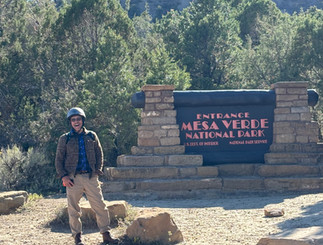Mesa Verde
- Hal Grant
- Sep 20
- 3 min read
Updated: Sep 21

Mesa Verde: A National Park Preserved to Honor People
On September 15, my husband and I ventured into Mesa Verde National Park. We had visited the Visitor Center and driven the scenic roads the day before and had made reservations for a ranger-led tour of Long House, one of the largest Puebloan dwellings in the park. The ride to get to Wetherill Mesa was steep and full of twists and turns, often requiring a speed limit of 25 mph, so it took just over an hour to get there. Afterward, there was a mile hike to the trailhead where we met our ranger.
The tour was fantastic. Through dirt pathways and ladder climbs, we explored the remains of the home of the Pueblo people who lived here centuries ago. It is estimated that the dwelling was constructed by the native people around 1150 AD and a community of people lived there until about 1275. There were probably 75-150 people living in the Long House over the years. Drought and overpopulation probably drove them to migrate to a new dwelling at that time, and there are still communities of ancestral Pueblo people in Arizona, New Mexico, and Texas.
The dwelling was built in the alcoves of the mountains which had been weathered over the years to create shell-shaped coves of rock. These coves provided protection from the extreme heat in the summer and cold snow in winter. Inside these coves, the native people constructed bricks from the rock and made walls out of these bricks and ceilings out of timbers and leaves, always using the mud of the weathered mountains as the glue to hold the dwelling together. The construction tells archaeologists a lot about the culture and structure of the communities that existed at that time.
The major food source for these natives was the corn which was grown on the mesa top. There were "clans" whose job it was to tend the crops during the growing season. The Puebloan people did not have horses or any other beasts of burden, so they used dogs to help with their plowing and carrying of crops. The corn was grown alongside beans and squash and made up most of the diet of these people. A different clan would be responsible for taking care of the dogs and also turkeys owned by the community. Turkeys were not used for their meat but instead for their feathers, which were woven together for blankets and baskets.
Inside the dwellings that we toured, there were circular rooms called kivas where clan members would meet to share information and get job instructions. There was also a large open space called a "dance hall" where all members of the community would gather for festivals and celebrations. Everyone on the mesas would be invited to these gatherings even if they lived on another mesa.
I asked our ranger if anything was known about the spirituality or religion of the people. He indicated that some had been converted to Christianity but still held their ancestral beliefs also. This included a belief that each living thing and even the non-living parts of the earth like water and soil had a spirit and energy and therefore was sacred. And so this land and even the remains of this dwelling are considered sacred to these Puebloan people. We were therefore asked to treat it with respect as you would someone else's home.
The experience of visiting Mesa Verde was enjoyable not only because of its geologic beauty but also for its cultural significance. It is the remains of a civilization that existed many years ago and reminds us that all people do best to respect and preserve our earth and its resources the way the Puebloan people did.
Lorraine Grant














Comments